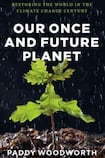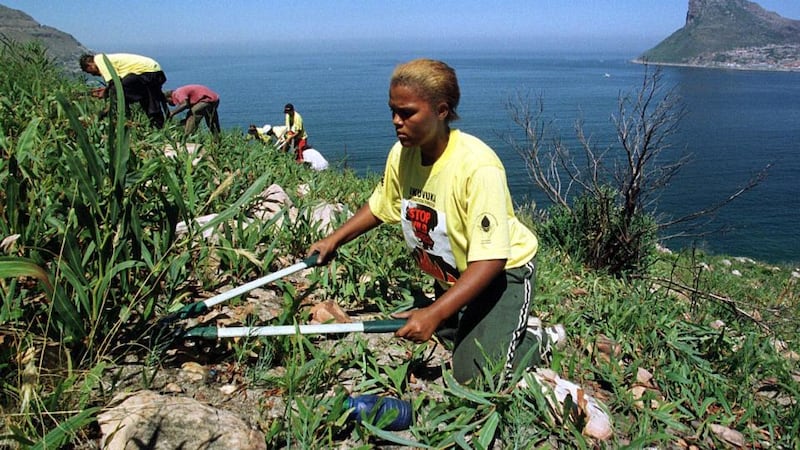
After the Pleistocene and the Holocene the planet’s Anthropocene epoch finds the latest anthropoid species swarming out of control. Increasingly resourceful in postponing its own mortality, it continues to exploit fellow species in the drive for comfort and power. Each day brings fresh news of its harm to surrounding life on Earth – now, indeed, to its own chances of survival.
So much for human folly. But, aware at last that nature matters, not least to humanity’s own needs, is there the will and the wherewithal – even, indeed, the remaining time – to make meaningful repairs to the planet? And what should be the priority: managed “ecosystem services” to humans, or nature left to its own unpredictable path? Can we have both?
With science presenting its latest ultimatum on global warming, Our Once and Future Planet explores the interim course of "restoration ecology". This is more ambitious and coherent than the piecemeal tree-plantings, prunings, reintroductions and clearings-up already familiar from greener news in the media. Its current global reach, scale and philosophical vigour are often surprising, and the years of travel and research by Paddy Woodworth, who writes regularly for The Irish Times, have produced an important book.

Chicago University Press saw its particular value at a time when American thought on the human contract with nature, as pioneered by Henry David Thoreau, John Muir and Aldo Leopold, confronts the new realities of climate change. The US remains the crucible and testing ground for their modern successors in ecology, and Woodworth’s time with projects for restoring prairie ecosystems and saving whooper cranes sent him travelling for wider examples of how new and often conflicting ideas are working out on the ground.
In South Africa he found “one ballsy programme”, as the late Kader Asmal described it. As minister for water affairs and forestry (fondly remembered in Ireland for his earlier anti-apartheid activism) he helped launch the Working for Water programme. His new nation was increasingly short of fresh water as alien and thirsty vegetation invaded the fynbos, the natural shrubland of the Cape, which holds its crucial watercourses. Asmal requisitioned money for a hugely ambitious public-works programme to clear the botanical aliens. At a stroke it would protect the unique biodiversity of the fynbos, restore water as the country’s “natural capital” and put wages in the pockets of the poor.
Woodworth explores this well beyond the programme’s botanical promise. His unthreading of political, economic and social forces at work, both for success and failure, gives his field studies a keen practical value. Restoration often brings dissent and conflict. Whether a cultivated landscape in Italy or woodland “wilderness” beside Chicago, change is as much about people, their priorities and their attitudes as it is about the natural ecosystem.
In New Zealand, tensions are cultural, given Maori traditions of land ownership. In Australia, too, the lives of aboriginal people and the prospects for mining both complicate the ambitions of the Australian Wilderness Society. “Dreamtime in Gondwanaland”, Woodworth’s chapter from the bush, is richly described.
Even in South America, restoration ecology reaches back through history to connect with earlier human and natural ecosystems. In southern Mexico what is left of the Lacandon Jungle is one of the most diverse stretches of Atlantic rainforest left in North America. But next to it are clearances to pasture, the introduction of African grasses and the steady degradation of overgrazing. Here restoration must reach out to the knowledge of the neighbouring peoples of the forest, once part of the Mayan civilization.
The Irish examples, modest enough by world standards, also happen to encapsulate some of the concepts that keep the restorationists, as Woodworth puts it, “buzzing with energy – and with vibrant contradictions”. In north Co Mayo, the experimental rewetting of Bellacorick’s cutaway bog to nurture the regrowth of peat is, for ecologists, restoration of a habitat with special value to biodiversity, reassembling the bryophyte species that were creating bog 4,000 years ago.
Along with its special ecosystem and value in flood control, Woodworth could have added the new selling point for peatland. As a sink for human-generated carbon dioxide it fits well into economics as “restoration of natural capital”, a motive for restoring habitats that both puts a cash value on nature and wins funding from sceptical governments. It is becoming a dominant strand in ecological restoration but struggles with others, no less vigorous, that seek to put nature’s own energies first. Woodworth explores all of them, in lively and thorough engagement with their leading thinkers.
Even without obvious economic motive, the approach to restoration is often dubiously framed by human preference. Where should ecologists start in deciding on change? Take Brackloon Woods in Co Mayo, a flagship project in Irish restoration in which Coillte removed the alien conifers planted on old estate land, leaving the grand old oaks, their boughs garlanded with ferns and lichens, as a clearly more natural ecosystem.
In only a decade, replanting of other native trees, reared from local seed, and the flourishing of ferns and flowers have produced, as Woodworth found, a remarkable, even “inspiring”, example of rapid regeneration. But how much of this preferred alternative state is authentically natural and enduring? Or is this an example of “wildlife gardening”, looking to historical references and suiting what people think should be there? Brackloon’s oaks are descended from planted originals. Fertiliser may be needed to keep the wood there at all. The authoritative Oliver Rackham sees the “natural ecosystem trajectory” of Atlantic woods such as Brackloon as melting ultimately into blanket bogs: should they be allowed to do so?
The guiding aim of “ecocentric” restoration is to put a degraded habitat back on something approaching its original path of development and variability and then standing back to let it get on with it, whatever the result. Woodworth quotes proponents of “a studied disregard of human interests”. And as climate change and the spread of alien species keep moving the goalposts – even, indeed, undermining the point of research – some argue that “novel ecosystems” may have to be accepted and resources no longer squandered on unattainable goals of restoration.
Woodworth ultimately finds himself fighting for the middle ground. "For most of the human world," he writes, "restoration will have to find a convergence between our self-interest and whatever ideological commitment to the conservation of biodiversity our cultures may have – or it simply will not happen at all." His book is a stimulating field guide to some of the options on offer.
Michael Viney has been writing the Another Life column since 1977












